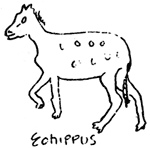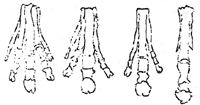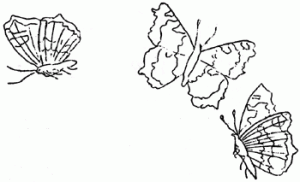My Kingdom for a Horse
 There was once a little animal No bigger than a fox, And on five toes he scampered Over Tertiary rocks. |
It has often been said that from the point of view of the geologist there is little distinction between the Great Ice Age and the Recent Epoch, the Age of Man. The former ended in the United States when the last continental glacier in its northward retreat, about 35,000 years ago, abandoned the United States. When we can gather more evidences of carbonized vegetation, possibly further search may reveal specimens beneath the contacts of the dacite flow of Llao Rock and the glaciated base on which it rests, we shall be able to tell with greater accuracy the approximate age of the entombment.
It is quite evident that the destruction of Mount Mazama occurred quite recently, speaking in geological terms, and the sculpturing process is still actively being carried on. From year to year hug spawls of rock tumble into the lake. One day last week a rock slide occurred along the face of Cloud Cap and the dust continued to rise along the talus slope for nearly two hours. This season a huge fragment broke from the extreme west end of the Phantom Ship, thereby making more slender one of the spars of The Ship.
It is apparent that the several carbonized logs are but preservation of pre-existing life and consequently can be called fossils. Fossils are they symbols in which the history of the world’s life is written, an a knowledge of the symbols is necessary before the story can be read. Animals and plants that lived long ago were buried in mud in sedimentary regions or in ash in volcanic regions just as those of today are being so buried in some places. The mud hardened to rock or the ash became indurated and then subsequent layers have been worn away as the mountain has been eroded by the action of wind, water and ice, and there is good probability that subsequent discovery will reveal the remains of animal or plants which were entombed in Tertiary or Pleistocene time. May we have additional discoveries. Who knew, but there is buried in the volcanic ash and pumice the bones of a Tertiary horse? It certainly would be a great pleasure to find the bones turned to stone of say the four-toed horses (Eohippus) or the early three-toed horses (Mesohippus) or the later three-toed horses (Merychippus) or the one-toed(Equus). If any of the above should happen to be found we would have the fossil index to the Eocene, Oligocene or Miocene epochs of the Tertiary Period of geological time and to the Pleistocene and Recent epochs — in case the find should happen to be a one-toed horse.
There have been fossil bones of the early horse discovered to the north and east of this region. Of course it is very doubtful if we ever will find the bones of such previous life in the vicinity of Crater Lake since it is apparent that the heat was so great and very probably organic material would have been consumed by the excessive heat.
A Butterfly Pilgrimage
By Lincoln Constance, Ranger-Naturalist
Crater Lake is experiencing a migration of butterflies resembling the flights of locusts which perturbed the Pharaohs of Egypt in ancient times. About the South Rim one encounters hundreds of these insects, but on Garfield and Scott Peaks one may see thousands and tens of thousands, and multitudes are reported to be on the wing elsewhere.
They seem to fly from all directions, headed for everywhere at once, like a confused whirl-wind. Most of them, however, cross the Lake from the north, perhaps in anticipation of a pleasant winter in California, but many are enamoured by the beauty of Crater Lake, and fly around the Rim. When automobiles arrive, the front of their radiators are lavishly decorated with the mottled orange wings of these butterflies.
The great majority of these insects are the California Tortoise-shell Butterflies (Aglais californica Bdv.), whose wings are brilliant orange within, but grayish-brown on the outer surfaces. When they settle upon a tree trunk, or a stone, or a stray Ranger, they close their wings, and become very inconspicuous, safe in their protective camouflage. But the instant the wings are opened, the momentary concealment vanishes completely. It seems to be a conception of wide popularity that butterflies live for only a few days at best, but these insects refute that theory, and actually hibernate over the winter! The black, velvety caterpillars feed on various species of the Mountain or California Lilac(Ceanothus), which locally pass under the names of Snowbrush, Deerbrush or Buckbrush. A few whiter butterflies: Pine Whites (Neophasia monapia F. & F.), and Parassians (Parnassus clodius Mon.) are mingled with them, perhaps also succumbing to the vagrant urge.
The cause and destination of migratory movement has served tourists, and even newspapers, with much food for conjecture and speculation. J. A. Comstock, in his “Butterflies of California”, explains the phenomenon as follows:
“It is not the response to an instinct that prompts a southward movement in the fall for the purpose of overwintering in favorable environment, but rather is determined by the scarcity of food-plant, and perhaps to some extent by the sudden subsidence of the several parasites… When conditions are right for the production of swarms of this butterfly it is noted that the Ceanothus bushes are entirely defoliated over great stretches of territory in our mountains. The butterflies are compelled to move on to other districts in order to find sufficient food-plant on which to lay their eggs. We do not know factors that determine the direction of this movement. Possibly it is related to the prevailing direction of the wind since it is easier for butterflies to fly against the wind than with it.”
Tragedy lurks everywhere in the path of the voyagers. Automobiles and careless pedestrians take a heavy toll, but many more drop too near the water, and are drawn to its glassy, treacherous surface. While this may be a calamity to the butterflies, the fish appear to appreciate the addition to their staple diet, and may frequently be seen jumping for a highly ornamented, tasty morsel.



